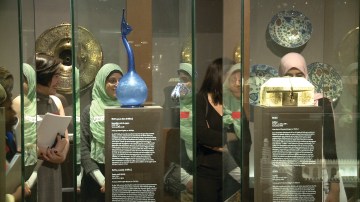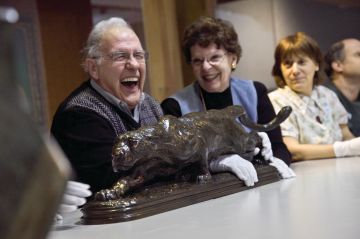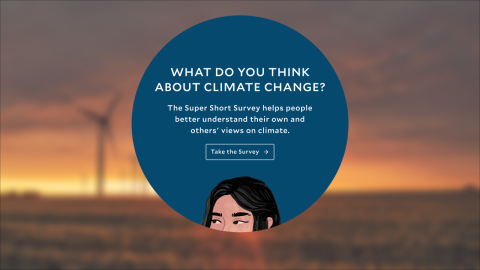
For two decades, the Montreal Museum of Fine Arts has nurtured resilience and renewal through its programs and practices.
This article originally appeared in the November/December 2019 issue of Museum magazine, a benefit of AAM membership.
Twenty years ago, the Montreal Museum of Fine Arts (MMFA) embarked on an adventure unique for a Canadian art museum. With the support of several private foundations, we developed an educational program, initially called “Bridging Art and the Community,” that allowed us to reach out to underserved populations, such as people who are adapting to a new country and learning a new language, those coping with mental or physical health problems or intellectual disabilities, and those struggling with unemployment and poverty.

To start, we contacted nonprofit community organizations and governmental social services that serve these vulnerable individuals. By offering these groups free access to our educational programs through guided tours of our exhibitions and collections or creative art workshops, we aimed to make the museum more relevant and meaningful in people’s lives.
By 2004, the program had successfully built trust and created partnerships with the community. Our partners told us—through focus groups and ongoing evaluations—that they wanted long-term projects specifically designed for the needs and interests of the people they work with.
We renamed the program “Sharing the Museum” and began offering these special projects free of charge, as with all of our educational activities. Over the past 20 years, we have worked with more than 400 organizations co-designing the projects and constantly assessing their pertinence for the participants, the organizations, and the museum. At last count, “Sharing the Museum” has touched more than 230,000 individuals.
Doing More with Well-Being
Early on, as we worked not only with individuals in fragile physical or psychological health, but also with literacy groups, cultural communities, newly arrived and longer-term immigrants, homeless individuals, youth dealing with physical and verbal abuse, and people with disabilities, we decided that we wanted to specifically address well-being.

In 2006, we began researching what other museums around the world were doing and found that cultural organizations in the United Kingdom were at the forefront of this work. In 1997, the British organization Comedia found that arts participation had a significant impact on personal development, social cohesion, community empowerment and self-determination, imagination and vision, and health and well-being. Numerous UK organizations were implementing programs and studying the link between arts and health, including Manchester Metropolitan University’s Arts for Health program and Durham University’s Centre for Arts and Humanities in Health and Medicine (now the Institute for Medical Humanities).
And in the US in the late 1990s and early 2000s, Lois H. Silverman was documenting her work with several museums in Indiana to develop art programs with older adults experiencing mental health issues and adjustment disorders, adults who were at risk for psychiatric hospitalization, and people with HIV/AIDS who needed mental stimulation and motivation. Evaluation of these pilot programs indicated that museums have great therapeutic potential and can help decrease social isolation.
In 2010, Silverman published The Social Work of Museums, which described the interdisciplinary work museums were doing with social agencies to address personal hardships of vulnerable people and ultimately tackle social injustices. This same year, MMFA began expanding its work to positively affect well-being, over the next few years working with Alzheimer’s patients and caregivers, Black artists, people with eating disorders, and young people with mental health issues. (See Timeline starting on p. 30 for details of our work.)
Where We Are Now
In the past three years, “Sharing the Museum” has diversified to include several new initiatives.

In 2017, we hired a full-time certified art therapist to further develop the role of art in health. That same year we opened the Art Hive, a community art studio or a “public homeplace.” Founded by art therapy professor Janis Timm-Bottos of Concordia University, Art Hives (arthives.org) are a network of inclusive art studios, open to everyone, that seek to create opportunities for creative exploration, social deisolation, personal and community development, and skill sharing.
The Art Hive of the MMFA, the only one in a museum setting, welcomes participants twice a week on a drop-in basis during set hours. The activities are self-directed and borne of the creative endeavors of each person. The space is staffed by an art therapist and a museum mediator (educator) who greet and offer creative support to each person, whether a regular participant, a museum patron, a family, a tourist, or someone who has been recommended by a social or health service (see “Museum Prescription” information on the next page). The space can also be reserved for groups, such as those working with people with mental health issues. The Art Hive of the MMFA currently welcomes more than 2,500 participants a year.
In addition, we also have a dedicated “Health and Well-Being” program that provides movement-related activities in the galleries and studios for individuals on the autism spectrum, individuals with Parkinson’s disease, and more recently people with ALS. The newly created “World Cultures and Togetherness” program reaches out to groups from diverse cultural communities, working to create dialogue based on discussions in the galleries. And we have opened a free adolescent space, which is equipped with art materials and audiovisual equipment, available to youth groups by reservation.
And this year, the MMFA launched the pilot “Museum Prescription” program. The program was co-developed with an association of Canadian francophone doctors (Médecins Francophones du Canada) and allows participating doctors to prescribe museum visits to any patients they think might benefit. The prescription, which is also open to the patient’s family, allows free access to any of the museum’s five pavilions, exhibitions, and ongoing activities for families, seniors, and the community at large. The museum and the numerous donors that contribute to the community and wellness programs currently cover the cost of the free admissions associated with this program. Eventually, we hope the costs would be covered by insurance if the program continues. Since November 2018, nearly 300 museum prescriptions have been filled. This partnership reaffirms the principles upon which “Sharing the Museum” was founded: art and the museum can positively affect the health of the individual, the family, and the community.

The museum also co-produces research studies and published papers related to several projects, thus contributing to the growing literature on museums and health. For example, our program with the Douglas Mental Health University Institute (see Timeline on p. 31 for details) has resulted in two published papers on eating disorders (see Resources on p. 31), a paper currently under review on the effects of our museum program with the Centre hospitalier universitaire Sainte-Justine for youth suffering from mental health issues, and research on the effects of our Beaux jeudis program that offers seniors creative art workshops free of charge, among others. Notably, research on “Sharing the Museum” has shown that it creates a sense of belonging for vulnerable people.
In retrospect, we believe that our gradual evolution with this work, and our continual evaluation of it, have been essential to our success. We encourage any museum wishing to establish something similar to proceed slowly, ensuring that you have sufficient resources and that, above all, you listen closely to your community.
Timeline
1999
The MMFA started the “Bridging Art and the Community” program.
2004
“Bridging Art and the Community” was renamed “Sharing the Museum.”
2010
In partnership with the Alzheimer Society of Montreal, the MMFA developed a program for individuals with dementia and their caregivers modeled on the Meet Me at MoMA program at the Museum of Modern Art in New York. Today, the program continues with four other organizations participating.
2011
Through the generous gifts of Michel de la Chenelière, the MMFA began expansion of its educational spaces. The museum now has the largest educational complex in North America, with a total of 3,588 square meters of space and 17 full-time staff currently; 25–30 part-time educators, depending on the season; and more than 150 volunteer docents.
2013–14
With the Michaëlle Jean Foundation, the MMFA created “The 4th Wall” project with eight emerging artists from Montreal’s Black communities. In our studios, the artists created works that confronted clichés, denounced racial discrimination in urban settings, and interrogated the representation and construction of identity, women’s rights, and intercultural relations while reminding us of universal values like justice, beauty, liberty, spirituality, and the march of history.
2014
In a partnership with the Douglas Mental Health University Institute, the museum used a certified art therapist for the first time, designing a museum activity for patients with eating disorders. The Douglas Institute research team and Concordia University’s art therapy graduate program have helped the museum empirically measure the benefits of an arts-related program in the context of mental health. The project is ongoing.
2014
The MMFA began working with Ste-Justine Hospital on its arts initiative that helps young patients with mental health issues. “Espace Transition” uses drama, circus arts, music, and now visual arts at the MMFA to help youth integrate into social groups, such as arts professionals, non-patients in their age range, and the general public. The program is ongoing.
2014
An education officer for well-being was hired to develop programs for people on the autism spectrum.
2016
Informed by the Michaëlle Jean Foundation and the Institute for Research and Education, “The Art of Inclusion: Muslim Youth Take the Lead” featured 10 young artists whose work conveyed ideas about enhancing the integration of Muslim youth in Quebec and Canadian society.
2017
The MMFA hired a full-time art therapist and opened an Art Hive. (See p. 32 for more detail.)
2018
The MMFA Art and Health Advisory Committee formed. It is composed of experts in health, art therapy, research, and the arts to support the museum’s art and wellness initiatives.
2019
In partnership with Médecins Francophones du Canada, the MMFA begins the “Museum Prescription” program.
Resources
Lois H. Silverman, The Social Work of Museums, 2010
Gwen Baddeley, Laura Evans, Marilyn Lajeunesse, and Stephen Legari, “Body Talk: Examining a Collaborative Multiple-Visit Program for Visitors with Eating Disorders,” Journal of Museum Education, 2017 tandfonline.com/doi/full/10.1080/10598650.2017.1379278
Lea Thaler, et al. “An Adjunctive, Museum-Based Art Therapy Experience in the Treatment of Women with Severe Eating Disorders,” The Arts in Psychotherapy, 2017 sciencedirect.com/science/article/abs/pii/S0197455617300126
Marilyn Lajeunesse is the educational programs officer–adults and community groups and Stephen Legari is the educational programs officer–art therapy at the Montreal Museum of Fine Arts.






